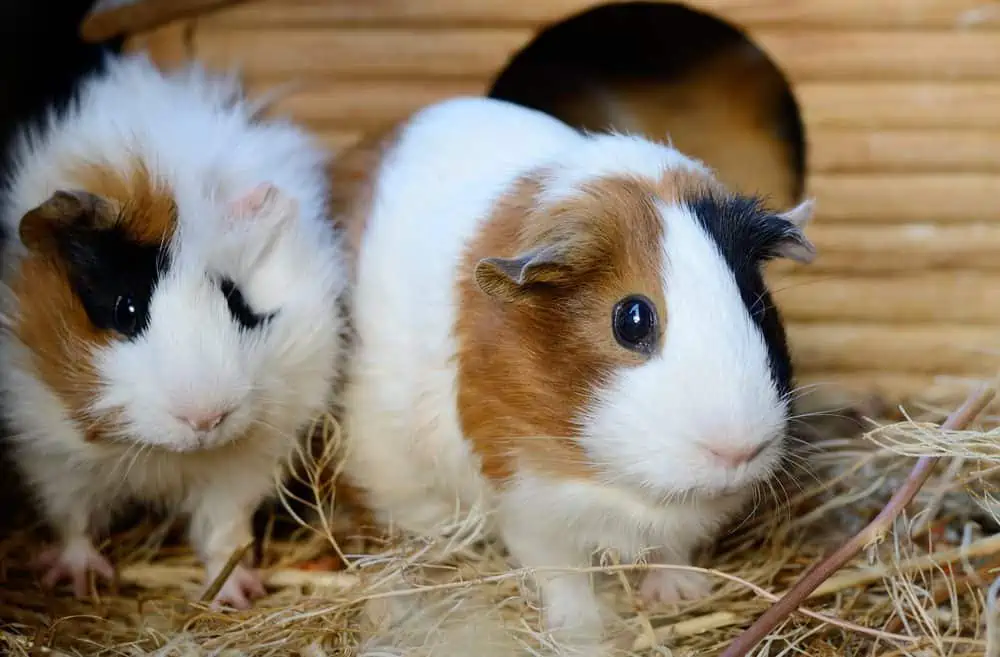
Sociable, inquisitive and affectionate, guinea pigs are often considered a good first pet for children. However, it should always be an adult that takes responsibility for these chatty little rodents to ensure they are cared for properly. This is particularly true when it comes to managing their diet.
To keep your guinea pigs happy and healthy it’s essential that they keep their digestive systems busy with a mix of two kinds of fibre – known as digestible and indigestible fibre – moving through the gut at all times. Piggies get this fibre mainly from good quality feeding hay. This is how the process works:
- Indigestible fibre is moved through their digestive system and excreted as separate, rounded, hard droppings. This type of fibre keeps the digestive system moving and their appetite stimulated.
- Digestible fibre is moved up into an organ called the caecum – which is like a giant appendix. Good bacteria in the caecum ferment the fibre, making it easy to digest. This emerges in the form of clumps of sticky droppings, known as caecotrophs. Then, while this might seem rather off-putting to us humans, guineas re-eat the caecotrophs directly from their bottom. Essential nutrients are absorbed when the digestible fibre passes through for the second time.
If guinea pigs don’t get the right amounts of both digestible and indigestible fibre, it can rapidly lead to serious health problems. Following the Excel 5-step Feeding Plan, which was developed in conjunction with one of the world’s leading small-animal vets, will provide your guineas with the perfect daily balance of fibre and nutrition.
Step 1: Burgess Excel Feeding Hay
High quality feeding hay such as Dandelion & Marigold should form most of your guinea pigs’ diet. Hay is also good for dental health as the gnawing action required to eat it helps to wear down their continually-growing teeth. Overgrown teeth can be the cause of potentially fatal problems in guinea pigs.
Step 2: Burgess Excel Nuggets
Excel nuggets with Blackcurrant & Oregano are tasty nuggets packed with nutrition. High in ‘beneficial fibre’ to promote digestive health, they also contain vitamins, minerals and prebiotics to help with healthy eyes, skin and coat. Importantly, they also prevent selective feeding – unlike muesli-type foods where small animals just pick out the high starch/sugar components, leading to all kinds of health issues.
Step 3: Burgess Excel Nature Snacks
These delicious, natural and healthy snacks such as Apple Snacks or Meadow Herbs are ideal for guinea pigs as they prevent boredom and promote emotional health. They can also be used to encourage bonding and interaction between you and your pets – feeding by hand can help your guinea pigs become comfortable with human attention.
Step 4: Fresh greens
Guinea pigs can be fed fresh greens to give additional nutrients and to provide some variety. You need to be careful which greens you feed and how much. Each day, you could alternate a small bunch of parsley, a couple of dandelion leaves (ensure they have not been sprayed with pesticides or are from an area where wild rabbits graze, as they could carry disease), half a curly kale leaf, one small floret of broccoli or 1/8th of a green bell pepper.
Step 5: Fresh water
Piggies should have access to fresh water every day.
DID YOU KNOW?
Like the sailors of old, guinea pigs can suffer from scurvy. This is because, just like humans, guinea pigs can’t make their own Vitamin C and need to get it from their daily diet.
Foods to avoid
Never feed your guinea pigs with human food – chocolate and dairy products are particularly dangerous and citrus fruit can upset their sensitive tummies. Also avoid potato, nuts, onion and related vegetables, rhubarb, tomato leaves, buttercups, daffodils, poppies and tulips.
Keeping in shape
As well as giving your guinea pigs the right nutrition, it’s essential that you provide them with spacious accommodation so they can get all the exercise they need to maintain a healthy weight. Traditional small hutches do not provide the space guinea pigs need to behave normally – they are active for up to 20 hours a day. A hutch should just be viewed as your guinea pigs’ ‘bedroom’ and be permanently attached to a much larger run. Scattering food around their accommodation will encourage them to be active and express their natural foraging behaviour.
You can check if your pets are healthy size using this handy Guinea Pig Size-O-Meter >>
If you found this interesting, you may also like:
Have your guinea pigs had their vitamins today?
Just like us, guinea pigs need their daily dose of vitamin C to stay healthy. Are your piggies getting the right amount?
Bonding with your small pets
Hand-feeding is a great way to build a closer bond with small animals. It takes time to build trust, but when your little friend finally feels confident enough to take a treat from your hand, it’s a special moment.
Our 7-point guide to being a gold-star guinea pig owner
Guinea pigs have been popular pets for generations. Today, we are better informed about how to care for these friendly little creatures, so that we can provide them with everything they need to enjoy happy and fulfilling lives
12 fun facts about gorgeous guinea pigs
When it comes to guinea pigs, what’s not to love? But how much do you know about these highly social, scent-marking, mid-air spinning small furries?
Source: pfma.org.uk














